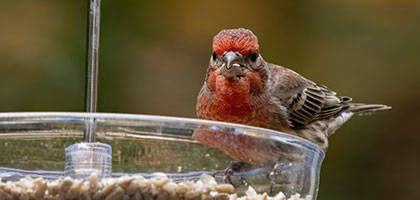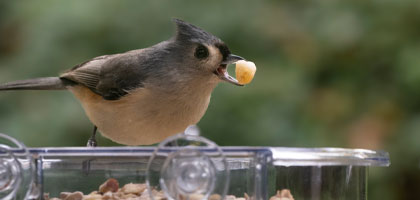Feeding finches can be a rewarding experience. It's a chance to observe these vibrant birds up close and contribute to their well-being.
But what is the best bird seed for finches?
This question is crucial for bird enthusiasts. The right seed can attract a variety of finch species and provide them with essential nutrients.
In this guide, we'll explore the preferences of finches, from their favorite seeds to the types of feeders they're drawn to. We'll also delve into the importance of seed quality and hygiene in finch feeding.
By understanding these factors, you can create a finch-friendly environment in your backyard. Let's embark on this journey to becoming better bird feeders.
Understanding Finch Preferences
Finches are not picky, but they do have preferences. Nyjer (thistle) seed stands out as a favorite due to its small size and high oil content. Its rich nutrients make it a perfect choice for finch feeders.
Aside from Nyjer, finches benefit from a mixture of seeds. A well-balanced blend caters to different species and nutritional needs. Here's what to consider for a seed mix:
- Nyjer (thistle) seed
- Various seed types to cater to different finches
Understanding these preferences helps ensure that your backyard remains a popular spot for these delightful birds.
The Importance of Seed Quality
High-quality bird seed is essential for finch health. Fresh seeds provide the necessary nutrients that finches need. Stale or low-quality seed can lead to nutritional deficiencies.
Choosing the right seed mix involves avoiding fillers like milo or oats, which finches often ignore. Opting for premium brands ensures that every seed in your finch feeder contributes to the bird's diet. Always check the freshness of the seeds before purchasing.
Popular Seeds for Finches
Finches have specific preferences when it comes to seeds. Nyjer, also known as thistle seed, tops the list. This tiny, oil-rich seed is packed with energy and highly favored by finches. Nyjer seed’s small size perfectly suits their beaks, making it a staple in finch feeders.
Sunflower seeds, particularly hulled or chips, are also popular. They provide essential fats and proteins, supporting finch health. These seeds are easy for finches to consume and digest. When choosing sunflower seeds, ensure they are clean and free from mold to promote finch well-being.
Millet is another excellent seed type, particularly white millet. Finches enjoy its taste and nutritional benefits. Millet is often included in seed mixes, offering balance. It caters to the dietary needs of various finch species, promoting diversity in the garden.
Lastly, canola and dandelion seeds can be appealing options. While not as popular as Nyjer or sunflower seeds, they are worth considering. These seeds add variety to the feeder and support a balanced diet for finches. Including diverse seed types can attract more finches and enhance their feeding experience.
Finch Feeder Essentials
Choosing the right finch feeder is crucial for providing the best experience. Tube feeders are ideal, as they are perfect for holding small seeds like Nyjer. Mesh feeders are also popular since they let finches cling comfortably while feeding. These feeders cater to finches' unique needs and keep seeds in place.
Placement and maintenance are vital for attracting finches and maintaining hygiene. Position feeders in a quiet, sheltered spot to entice finches. Regular cleaning is essential, as it prevents disease and keeps finches coming back. Maintaining a clean feeder ensures a safe dining experience for these birds.
Equipping feeders with multiple feeding ports is also important. This feature allows more birds to feed simultaneously, reducing competition. Multiple ports encourage a flock of finches to visit your garden. By accommodating several birds at once, you create a welcoming and efficient feeding environment.
Attracting Finches to Your Garden
Creating an inviting garden environment is key to attracting finches. Brightly colored feeders can mimic flowers and capture the attention of these vibrant birds. Colors like red and yellow are particularly effective in drawing finches to your space.
To further entice finches, consider providing a nearby water source. A simple birdbath not only offers drinking water but also a refreshing spot for finches to bathe. Ensure the water is clean and fresh to keep these birds returning.
A sheltered location adds another layer of appeal. Position your feeder near trees or shrubs to provide a sense of security. Finches prefer areas that offer protection from predators and harsh weather. Here's a quick list for success:
- Brightly colored feeders
- Providing a water source
- Sheltered location
Seasonal Considerations and Variety
Finches' dietary needs can change with the seasons. During colder months, they might prefer seeds high in fat, like sunflower seeds, to maintain energy and warmth. In contrast, the warmer seasons allow for a broader variety in their diet, as natural food sources become more abundant.
To keep finches returning year-round, it's vital to offer a diverse seed selection. Mixing seeds like Nyjer, millet, and dandelion can cater to various species' preferences. A variety in seed types not only supports their nutritional needs but also encourages a wider range of finches to visit. Consistently rotating seed offerings ensures that finches have access to their preferred choices through the year:
- Seasonal seed preferences
- Offering a variety of seeds
Health and Hygiene in Finch Feeding
Maintaining a clean finch feeder is crucial to prevent disease spread among birds. It's important to clean feeders regularly, removing any old seed hulls and debris. Using a mild soap solution and rinsing thoroughly can help keep feeders hygienic.
Equally important is ensuring the seed offered is fresh and free from mold. Moldy seeds pose health risks to finches, potentially leading to illness. Always store seeds in a cool, dry place to keep them fresh and appealing. It's beneficial to check seed stock frequently, disposing of any spoiled or old seeds promptly to maintain a safe feeding environment.
The Bigger Picture: Conservation and Community
Feeding finches is not just about enjoyment but also plays a role in supporting wild finch populations. This practice can provide vital resources during challenging seasons, helping finches thrive. By supplying high-quality seeds, we contribute to their health and breeding success.
Beyond conservation, feeding birds offers numerous personal and societal benefits. It fosters mental well-being by connecting us with nature and encouraging mindfulness. Moreover, bird feeding can educate children and adults about wildlife. It inspires community involvement through local bird clubs and citizen science projects, promoting both education and collective efforts. Embracing these aspects creates a rewarding experience for everyone involved.
Conclusion: Best Practices for Finch Feeding
Providing the best bird seed for finches requires thoughtful choices and attention to detail. Select high-quality seeds like Nyjer and sunflower that cater to their dietary needs. Avoid mixes with fillers that birds often ignore.
Maintaining a clean and well-placed feeder is essential for drawing finches safely. Regularly check the seed condition to prevent health risks from moldy food. By embracing responsible feeding practices and considering seasonal variations, you ensure finches enjoy a nourishing and safe meal. This approach not only supports the birds but enriches your birdwatching experience, creating lasting connections with nature.




